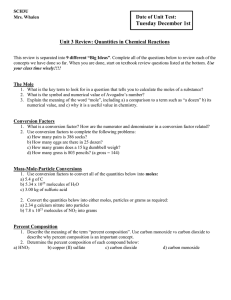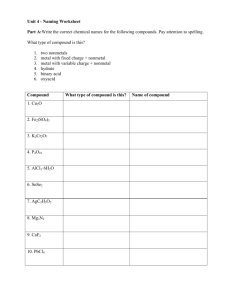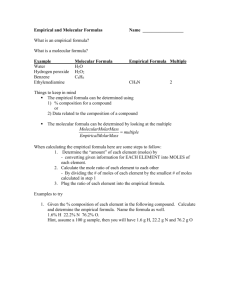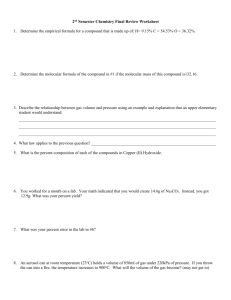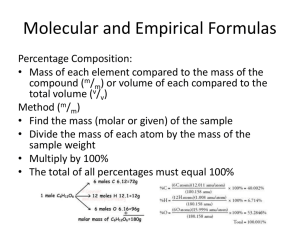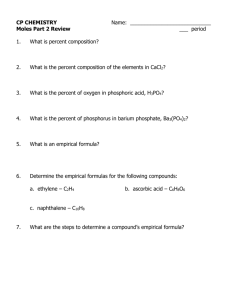Chemistry Unit 3 Review: Quantities in Chemical Reactions
advertisement
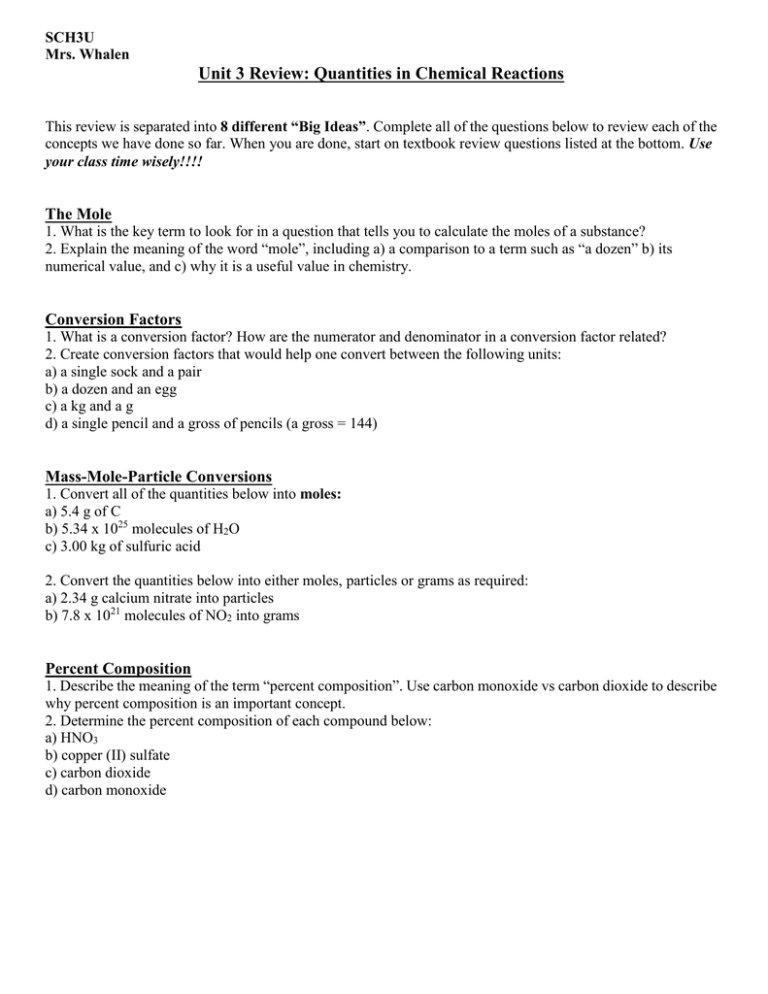
SCH3U Mrs. Whalen Unit 3 Review: Quantities in Chemical Reactions This review is separated into 8 different “Big Ideas”. Complete all of the questions below to review each of the concepts we have done so far. When you are done, start on textbook review questions listed at the bottom. Use your class time wisely!!!! The Mole 1. What is the key term to look for in a question that tells you to calculate the moles of a substance? 2. Explain the meaning of the word “mole”, including a) a comparison to a term such as “a dozen” b) its numerical value, and c) why it is a useful value in chemistry. Conversion Factors 1. What is a conversion factor? How are the numerator and denominator in a conversion factor related? 2. Create conversion factors that would help one convert between the following units: a) a single sock and a pair b) a dozen and an egg c) a kg and a g d) a single pencil and a gross of pencils (a gross = 144) Mass-Mole-Particle Conversions 1. Convert all of the quantities below into moles: a) 5.4 g of C b) 5.34 x 1025 molecules of H2O c) 3.00 kg of sulfuric acid 2. Convert the quantities below into either moles, particles or grams as required: a) 2.34 g calcium nitrate into particles b) 7.8 x 1021 molecules of NO2 into grams Percent Composition 1. Describe the meaning of the term “percent composition”. Use carbon monoxide vs carbon dioxide to describe why percent composition is an important concept. 2. Determine the percent composition of each compound below: a) HNO3 b) copper (II) sulfate c) carbon dioxide d) carbon monoxide Empirical and Molecular Formulas 1. Differentiate between the empirical and molecular formula of a compound using an example. 2. What pieces of information are required to calculate an empirical formula? What additional information is needed to find a molecular formula? 3. An unknown compound is found to consist of 40.1% sulfur and 59.9% oxygen by mass. Determine the empirical formula. 4. Resorcinol, a compound used to manufacture resins and drugs, is 65.44% C, 5.49% H and 29.06% O by mass. The mass of 1 mol of this compound is 110.0 g. Determine the molecular formula of the compound. 5. When a 3.862 g sample of silver oxide is heated, the remaining silver has a mass of 3.363 g. The molar mass of the compound is 247.74 g/mol. Determine the molecular formula. Stoichiometry 1. Use an everyday example to explain what stoichiometry is. Be sure to include an analogy for the reactants, products and chemical equation. 2. What unit is it absolutely necessary to convert to before you can use a stoichiometry ratio? Explain why this is the case. 3. When potassium chlorate decomposes, oxygen gas and potassium chloride are produced. What mass of oxygen can be produced from 5.78 g of potassium chlorate? What mass of potassium chloride is also produced? 4. Determine the number of molecules of ammonia that are produced when 43.5 g of nitrogen reacts with an excess of hydrogen to produce NH3. Limiting and Excess Reagents 1. Create an analogy using everyday items to explain the terms limiting and excess reagent. 2. Once the limiting and excess reagents are determined in a chemical reaction, which is used for calculations? Why? 3. A double displacement reaction occurs when 12.0 g barium nitrate reacts with 16.0 g potassium sulfate. Determine the mass of barium sulfate that will be produced by this reaction. 4. Calculate the mass of hydrogen that can be produced when 9.00 g HCl reacts with 7.00 g Mg. Percent Yield 1. Explain the term percent yield using the equation used to calculate it. 2. Why is it not likely to obtain a 100% percent yield when carrying out an experiment? 3. When 4.23 g of lead (II) nitrate is heated, 1.72 g of lead (II) oxide was produced, along with nitrogen dioxide gas and oxygen gas. Determine the percent yield of the experiment. Complete p. 170 #14, 19, 20, 37, 38 p. 208 #2, 4, 15 - 19, 21 p. 214 #5, 6, 7, 17, 38, 39, 40, 42a, 43, 44, 46, 51, 52, 53 Additional study tips: Review ALL notes Go over worksheets and try any you didn’t get a chance to complete, or retry those you did complete Keep trying problems again and again until you can do it without the help of your notes (including formula pages)
